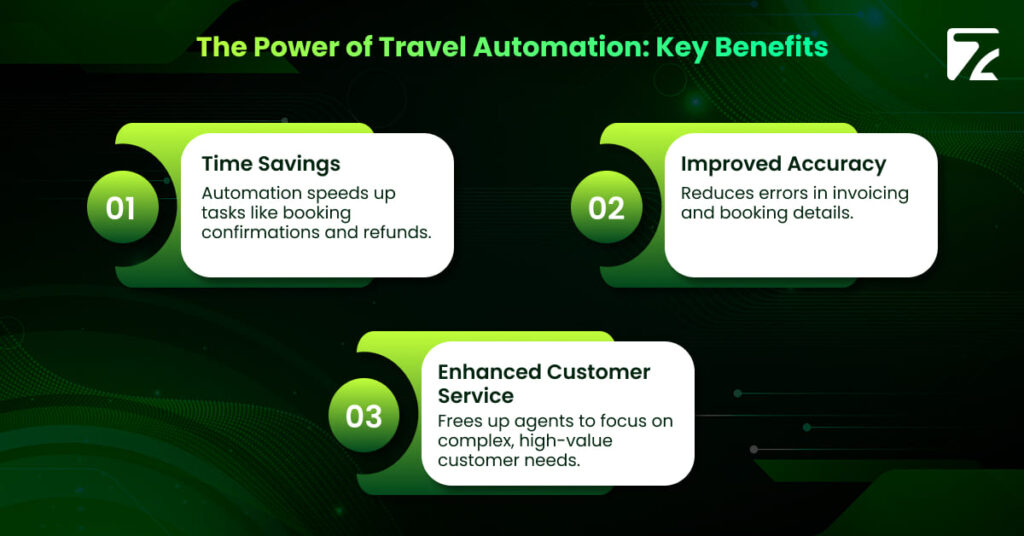This article is designed for professionals in the travel sector whether you’re part of a tour operator, OTA, B2B supplier, or a tech-forward BPO evaluating how to optimize client services. If you’re looking to understand how automation is reengineering the mechanics of modern travel operations, this guide offers a deep dive into its systems, use cases, and long-term impact.
We’ll look at what travel automation really means, where it delivers the most value, and why now is the critical time to adopt it.
A few years ago, reconfirming a hotel booking still meant someone usually a junior support staff sending an email, waiting for a reply, logging the update, and then calling the customer. Multiply that by 500 bookings a day, and you get why the travel industry started looking for better options.
Travel automation, in the simplest terms, is when that same process runs by itself. A system checks with the hotel via API, logs the confirmation, and sends a real-time update to the customer all without manual input.
But it’s more than just reconfirmation.
These systems now handle tasks across the board: pulling live rates from a supplier, syncing availability, flagging duplicate PNRs, or answering basic customer queries. Some use robotic scripts (known as RPA), while others rely on direct integrations or even machine learning to personalize responses.
The common goal? Reduce the need for someone to do what software can and let that person focus on more valuable work.

It’s not that the industry didn’t want automation before. It’s just that, for a long time, things worked “well enough.” Agents managed with email threads. Invoicing was done in spreadsheets. Customer service meant a phone call, and if it took 24 hours to confirm a hotel, well so be it.
That’s changed.
Travelers now expect everything to be instant. Confirmations, itinerary changes, refunds preferably in real time. And behind the scenes, companies are dealing with increasingly fragmented supply chains: direct hotel contracts, GDS feeds, wholesalers, last-minute add-ons. Keeping that all in sync manually? Not scalable anymore.
Add tighter margins, post-pandemic unpredictability, and the fact that most teams are running lean and you’ve got the perfect storm pushing automation from “nice to have” to “must have.”
It’s not just about saving time. It’s about keeping up with the way travel works now.
Automation sounds big and abstract until you see it in action.
Think of a mid-sized tour operator juggling 1,200 bookings a day. Some of those bookings come from an OTA partner, others from a direct client via email, and a few more from a DMC sending leads from Southeast Asia. Behind each booking are confirmations, invoices, cancellation terms, support queries, and maybe even a language barrier or two.
This is where automation steps in not to replace the team, but to amplify what they already do. Let’s break down a few real scenarios:
If you’ve ever handled hotel bookings, you know reconfirmations can turn into a rabbit hole. Automation tools now ping suppliers 48 or 72 hours before check-in, log the response, and even flag any issues before your customer gets on a flight. No more forgotten emails or missed calls.
Travel never sleeps but humans need to. A good automation setup routes common queries (like “Can I cancel my ticket?” or “Where’s my pickup?”) to chatbots that speak multiple languages and can escalate only when something truly requires attention.
If a customer prefers window seats, business class, or vegetarian meals, automation systems can remember that and apply it next time without anyone having to open a CRM manually. Some even suggest hotel upgrades based on past behavior.
Finance teams often spend hours matching bookings with supplier invoices. RPA bots can automatically pull the data, compare values, check for currency mismatches, and raise alerts for human review. It’s faster, and less prone to errors caused by long Excel nights.
In 2020, a mid-sized OTA based in the U.S. ran into something no spreadsheet could fix: an avalanche of cancellations.
Their team, which was already juggling late-night emails and urgent changes, suddenly had to process thousands of refund requests each week. Every case involved at least three systems checking the booking, reading the fare rules, then logging the refund manually. Some cases took nearly an hour. People were burned out.
Instead of hiring more agents, they tried something else.
They built a lightweight automation layer just a few scripts, tied into their CRM and booking portal. The results? Processing time dropped to under 6 minutes per case. More importantly, they freed up dozens of agents to handle high-priority exceptions, which in turn brought their customer satisfaction scores back up.
It wasn’t perfect, but it was enough to stabilize the team and keep them from drowning.
Every morning, a small operations team at Alpitour Italy’s largest tour operator had the same routine. Log into the airline systems. Download the latest charter bookings. Copy-paste the data into their internal tools. Rinse and repeat.
It wasn’t complicated work, but it took time. A lot of it. And mistakes, though rare, meant missed itineraries or misaligned invoices. No one liked doing it, but someone had to.
Eventually, they automated the process. Not with a big tech overhaul but with bots that mimicked human steps. Open the portal, fetch the data, push it to the right fields, send a log when done.
Each booking went from a 45-minute task to about 30 seconds.
The team didn’t shrink. Instead, they moved to more proactive work following up on failed bookings, checking airline changes early, improving customer communications. They were still doing ops. Just smarter.
You don’t need to be a developer to appreciate what makes automation work but understanding the moving parts helps. Travel automation isn’t powered by one system. It’s a mix of tools working behind the scenes, passing data, watching for updates, and stepping in when things don’t go as planned.
Here’s what’s usually in the toolkit:
Think of APIs as the wires connecting systems that were never built to talk to each other.
When a booking engine wants to check if a hotel room is still available, it pings the hotel’s system via an API. The same goes for syncing flight data from a GDS, checking pricing from a supplier, or sending confirmation details to a CRM.
The more travel companies rely on real-time data and let’s be honest, we all do the more these connections matter.
The problem? Not every system was built with APIs in mind. That’s why a lot of automation projects start not with flashy AI, but with simply getting your tools to play nice together.
RPA is less about cleverness and more about routine.
These bots don’t think they repeat. Log in here. Click that. Copy this number. Paste it there. Send an email. They’re great when you can’t integrate two systems directly but still need one to follow up on what the other did.
One travel company used RPA just to download hotel confirmations from an extranet, check them against internal bookings, and mark them off. It didn’t change their world but it saved one full-time role. That adds up.
This is where things get a bit smarter.
AI tools can spot trends like which bookings tend to get cancelled or which customers are most likely to call back. Meanwhile, NLP powers those chat tools that understand when someone types, “Can I change my hotel?” in five different ways and gives them an answer without a human ever getting involved.
Used well, these systems don’t just save time. They make the service feel more personal, not less.
No system rolls out without friction. Automation can absolutely help a travel business scale but only if you plan for the bumps.
Here are the most common ones:
| Metric | Why It Matters |
|---|---|
| CSAT | Did the customer feel satisfied? |
| NPS | Would they recommend you? |
| CES (Effort Score) | Was it easy for them to get help? |
| Bot Resolution Rate | Are bots actually solving problems? |
| Escalation Rate | How often are bots failing and passing it on? |
Most conversations about automation focus on speed and savings. And yes, it does both. But that’s not the full story.
What automation really gives you is space.
Space for your agents to spend time with the customers who need more than a form letter. Space for your finance team to spot problems early instead of scrambling to fix them late. Space for your ops staff to work smarter not faster.
In travel, timing is everything. A delayed reconfirmation, a missed refund, a mistyped invoice they all create friction. Automation smooths those edges, not because the tech is perfect, but because the process becomes less fragile.
The companies that win in this industry aren’t necessarily the biggest or the loudest. They’re the ones who figure out how to move fast without losing their touch.
Automation doesn’t replace the human element. It protects it.
Travel automation uses technology to handle repetitive tasks like booking reconfirmations, customer support, and invoicing, reducing the need for manual input and improving efficiency.
With increasing demand for instant service and complex, fragmented supply chains, automation helps companies keep up by streamlining operations, improving accuracy, and freeing up employees to focus on more valuable tasks.
Automation can be used in booking reconfirmations, customer support (like chatbots), itinerary personalization, invoicing, and financial reconciliation.
APIs, Robotic Process Automation (RPA), and AI/Natural Language Processing (NLP) are key technologies that help automate travel processes by connecting systems, performing repetitive tasks, and personalizing customer interactions.
Challenges include dealing with legacy technology, ensuring data security and compliance, managing fragmented processes, and ensuring team training and adoption.

Travel Automation Expert